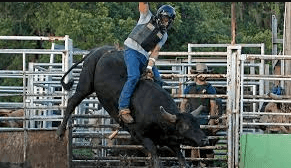What Are The Different Types Of Jumps In Cross-Country Riding?

In the realm of cross-country riding, where horse and rider navigate a challenging course filled with various obstacles, jumps play a pivotal role in testing their skill, agility, and bravery.
These jumps come in different forms and require the riders to demonstrate their mastery of both horsemanship and courage.
From log jumps that simulate natural barriers to water jumps that demand precision and accuracy, each type of jump presents its own unique set of challenges.
In this article, we will explore the different types of jumps in cross-country riding, shedding light on their characteristics and the skills required to conquer them.
The first type of jump commonly encountered in cross-country riding is the log jump.
As its name suggests, this obstacle consists of logs stacked together at varying heights.
Log jumps aim to replicate natural barriers found in forests or wooded areas.
They require riders to approach with caution and evaluate their horse’s stride length carefully to ensure a successful clearance over the logs.
Additionally, riders must maintain a balanced position throughout the jump while allowing their horses freedom to stretch over the obstacle without interference from reins or excessive contact.
Log jumps test both horse and rider’s ability to navigate through tight spaces while maintaining control and composure.
Another notable type of jump is the water jump.
These jumps involve crossing bodies of water such as ponds or streams within the course layout.
Water jumps pose unique challenges as they not only require precise timing but also demand trust between horse and rider due to potential uncertainty about stepping into an unfamiliar element.
Riders must approach water jumps confidently yet calmly, ensuring that their horses remain focused on successfully navigating through it without hesitation or resistance.
Proper technique involves maintaining impulsion throughout the entire jump while keeping balance despite any splashing or uneven footing caused by landing in shallow waters.
Overall, understanding these different types of jumps in cross-country riding provides insight into the intricate nature of this sport and highlights the skills necessary for success on demanding courses filled with diverse obstacles.
By mastering log jumps, riders demonstrate their ability to navigate through natural barriers with precision and control.
Water jumps, on the other hand, test the trust and synchronization between horse and rider as they conquer new challenges in unfamiliar terrain.
With this knowledge, riders can develop a comprehensive approach to their training, allowing them to excel in the exhilarating world of cross-country riding.
Log Jumps
Log jumps are a common type of obstacle encountered in cross-country riding courses. These jumps consist of logs that are placed horizontally across the course, creating a barrier for the horse and rider to clear.
There are various types of logs used in cross country jumping, including natural logs, which are sourced from trees and have a more rustic appearance, and artificial logs, which are man-made and can be designed to mimic the look of real logs.
The techniques for approaching and clearing log jumps require careful consideration by the rider. It is essential to approach the jump at an appropriate speed and angle to ensure a smooth takeoff. Riders must also maintain balance and control throughout the jump, as any imbalance could result in knocking down the log or even causing a fall.
Proper timing is crucial when asking the horse to lift its forelegs over the log while keeping its hindquarters engaged for a powerful push-off. Additionally, riders need to position themselves correctly in the saddle to allow their horses’ movement over the jump while maintaining stability and security.
Overall, log jumps offer both technical challenges and aesthetic appeal in cross-country riding courses, making them an exciting aspect of this equestrian discipline.
Water Jumps
A staple feature in the discipline, water jumps present an exhilarating challenge as riders navigate their mounts through the fluid obstacle, like a graceful swan gliding across a shimmering lake.
Techniques for approaching water jumps are crucial to ensure a successful and safe passage. Riders must maintain a balanced position, keeping their weight centered over their horse’s center of gravity, allowing for better control and balance.
It is important to establish an appropriate pace before reaching the jump, as going too fast can result in loss of control or refusal by the horse. Riders should also aim to approach the water jump at a slight angle rather than straight on. This helps horses to better judge the distance and depth of the jump, reducing chances of hesitation or stumbling upon landing.
Common mistakes riders make when navigating water jumps include leaning forward or backward, which disrupts their balance and can lead to falls or refusals by their mount. Additionally, riders may fail to give clear directives with their reins and legs, causing confusion for their horse and resulting in missteps or missed strides.
Practice and experience are key elements in mastering these techniques and avoiding these common errors when tackling water jumps in cross-country riding.
Bank Jumps
Bank jumps, also known as incline jumps, require riders to guide their horses up and over a steep slope-like obstacle, resembling a majestic ascent up a mountain peak.
These jumps can be both natural or man-made obstacles that test the skill and agility of both horse and rider.
Bank jumps challenge the rider’s ability to maintain balance and control while navigating the incline.
The horse must use its hindquarters effectively to push off from the lower ground and propel itself forward and upward.
The steepness of the slope adds an element of difficulty, requiring precise timing and coordination between horse and rider.
Riders must approach bank jumps with confidence and determination, as hesitation or lack of commitment can result in an unsuccessful attempt.
Overall, bank jumps provide an exhilarating experience for cross-country riders who seek adventure through conquering challenging terrain.
Frequently Asked Questions
What are the common materials used to construct log jumps?
Construction techniques and design considerations are key factors in creating log jumps for cross-country riding. Common materials used include sturdy logs, which are carefully selected and positioned to create challenging obstacles that encourage freedom of movement for both horse and rider.
How deep are water jumps typically?
Water jumps in cross-country riding can vary greatly in depth, with some reaching astonishing depths that can be intimidating for riders. Proper rider position is crucial to maintain balance and control. Techniques for tackling different depths include adjusting speed, stride length, and maintaining a strong core.
Are there any specific rules or regulations for riding through water jumps?
Rules and regulations for riding through water jumps in cross-country riding vary depending on the competition or event. These rules may dictate the depth of the water, the approach and exit angles, and the width of the jump to ensure safety for both horse and rider.
How high can bank jumps be in cross-country riding?
Bank jumps in cross-country riding can be approached effectively by building confidence and understanding the technique. Although there is no specific height limit, riders should focus on maintaining balance and rhythm to ensure a successful jump.
What are some safety measures to consider when jumping over log, water, and bank obstacles?
Safety equipment and proper technique are crucial when jumping over log, water, and bank obstacles in cross-country riding. Riders should wear helmets, body protectors, and appropriate footwear while using a balanced position and maintaining a steady rhythm to ensure safety.
Conclusion
Cross-country riding is an exhilarating equestrian sport that requires skill, precision, and a deep understanding of different types of jumps.
Three common types of jumps in cross-country riding are log jumps, water jumps, and bank jumps. Each jump presents its own challenges and requires specific techniques to navigate successfully.
Log jumps are one of the most common types of jumps in cross-country riding. These jumps consist of logs or poles stacked together to form a barrier for the horse and rider to clear. Riders must approach log jumps with confidence and maintain a steady pace to ensure a smooth takeoff and landing. It is crucial for riders to have good balance and control over their horse’s speed during log jumps.
Water jumps are another type of jump that adds excitement to cross-country courses. These obstacles typically involve crossing a body of water such as a pond or stream. Water jumps require both mental and physical preparation from the rider as they demand accuracy in judging the distance between the horse’s takeoff point and the edge of the water. Timing is everything when approaching water jumps, as too much speed can result in an unsafe landing or even falling into the water.
Bank jumps are challenging obstacles that test both horse and rider’s athleticism. These uphill or downhill slopes require careful navigation to maintain balance, rhythm, and power throughout the jump. Riders must adjust their position accordingly while preparing for bank jumps to provide support for their horses during takeoff and landing. The ability to read terrain is essential when approaching bank jumps as it helps riders determine how much impulsion is needed.
In conclusion, mastering different types of cross-country jumping requires knowledge, practice, and experience on various obstacles such as log jumps, water jumps, and bank jumosps.s Each obstacle presents unique challenges that demand precise techniques from both horse and rider.





